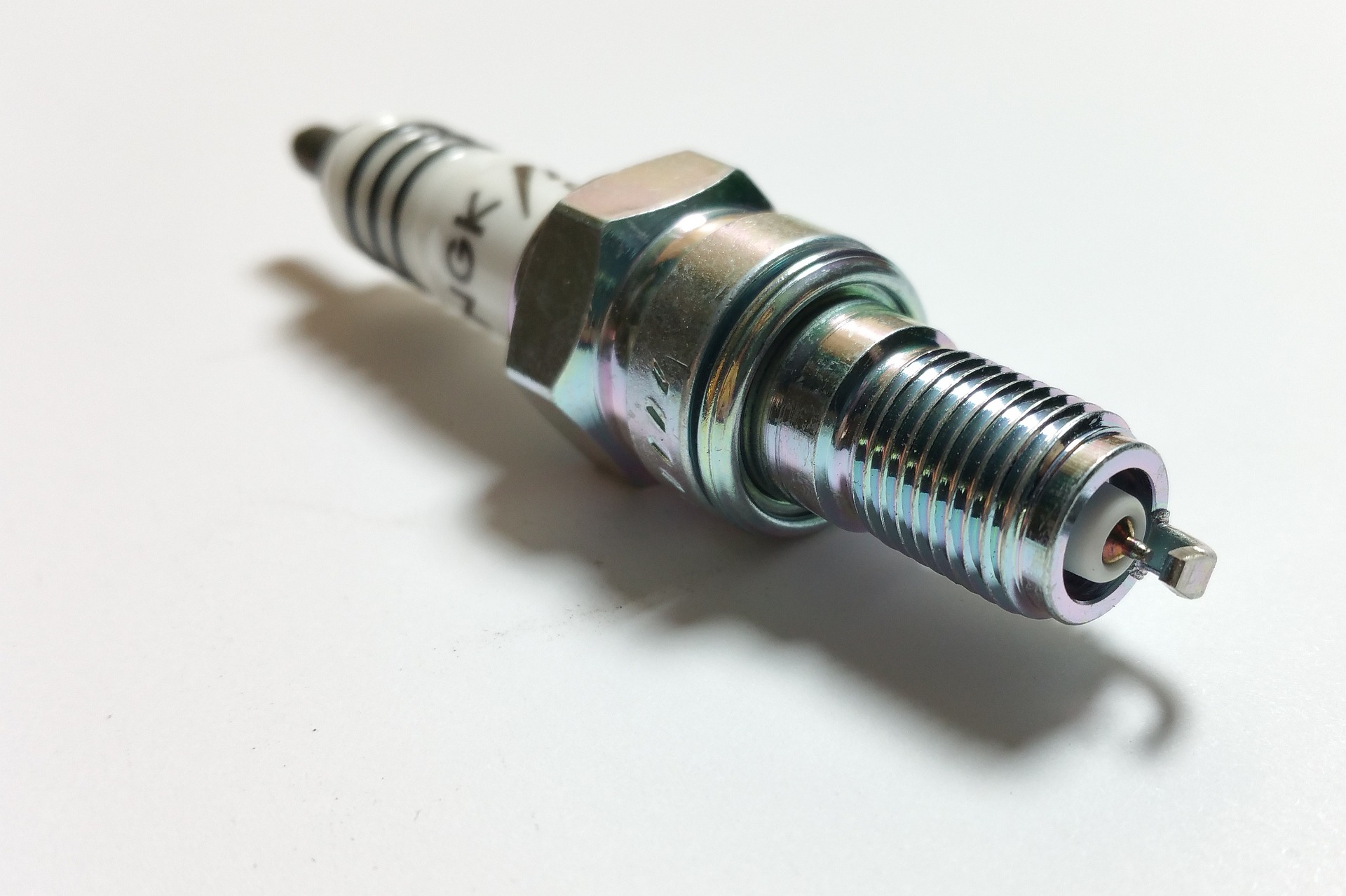Have you been told your car or truck has a dual ignition system? Or perhaps you’re considering purchasing a used vehicle that has dual ignition? It doesn’t mean you have two places to insert a key to start the car.
Rather, this type of ignition system leverages two spark plugs for a variety of advantages. Read on to learn how dual ignition systems work and why some manufacturers use this technology in their vehicles. We’ll also discuss spark plug and coil replacement in this scenario so you understand the process the next time you see your mechanic for a major tuneup.

What Is Dual Ignition?
A dual spark plug ignition system uses two instead of only one spark plug per cylinder in the combustion ignition process. You might recall that spark plugs ignite fuel to power the engine and move the vehicle.
Naturally, this type of ignition design is only found in gasoline-powered vehicles, as diesel engines don’t use spark plugs but instead rely on heat generated by highly compressed air.
In most dual ignition engines (aka twin spark plug engines), both spark plugs fire at the same time. We’ll talk about this more below in our explanation of twin spark plug systems in four-valve-per-cylinder engines, which is the exception to this process.
What Is the Purpose of a Dual Ignition System?
There are multiple benefits to a dual ignition system. Let’s take a look at why many automakers (and manufacturers of airplane engines) employ this technology.
Redundancy in case of failure
There’s a reason why dual spark plugs were used for decades in airplanes before they became popular in car engines (see more on dual ignition history below). With two spark plugs, if one fouls, there is a second plug to ignite the combustion reaction.
That’s less urgent in an automobile, truck, or motorcycle, but it can mean the difference between life or death in a plane. With a second spark plug to take up the slack should the other one fail, an engine can keep running when it would otherwise cease firing.
There is the possibility, of course, that both spark plugs could fail at the same time. But this is incredibly rare, especially in engines that are well maintained, whether they are in cars or in airplanes.
Spatial efficiency
In most vehicles with two valves per cylinder, it’s difficult (impossible, really) to centrally locate a spark plug between the valves for the most even ignition. Placing only one spark plug to the side creates slightly uneven and slower ignition, as it must travel across the cylinder. But using two spark plugs — one on each side — results in more even ignition.
Ignition advance
For maximum combustion efficiency, you also want to time spark plug ignition perfectly with the movement of the engine’s pistons. Ignition advance starts the firing process a bit early in an attempt to do this by having the spark plugs fire a split second sooner than they might otherwise.
But there is a limit to how much ignition advance can be utilized without creating a conflict with the force of the pistons. The solution is to use two spark plugs (dual ignition) on either side of the valve. The flame front is shortened and combustion time is decreased for that highly desirable efficiency.
Improved fuel economy
The use of dual spark plugs and its associated combustion efficiency also boosts fuel economy. Vehicle owners can enjoy a slightly leaner air-to-fuel ratio with double spark plugs, which ends up with them using less gasoline. This, in turn, means fewer trips to the pump over the long term and less money spent on fuel.
What About Cars with Four Valves per Cylinder?
The discussion above references vehicles that have two valves per cylinder. The use of dual spark plugs changes somewhat when you have four valves for each cylinder, like you’ll notably find in some Alfa Romeo models.
In this scenario, it’s not feasible to position two spark plugs equidistant from the chamber centre. So, two spark plugs are used, but there is a main spark plug in the middle of all four cylinders with a second smaller plug positioned off to the side as an auxiliary. The two plugs, rather than firing simultaneously, fire a few milliseconds apart.
How does that maximize combustion efficiency? It doesn’t, really. However, it does improve vehicle emissions. Any unburned fuel remaining after the first plug fires is burned up by the second plug. This produces a cleaner burn, and, as a bonus, it reduces engine knock and long-term engine damage.
Are Twin Spark Systems a New Invention?

By Unknown photographer – Public Domain, https://commons.wikimedia.org/w/index.php?curid=83632972
Believe it or not, dual ignition cars have been around for over 100 years. The first known twin spark engine was in the 1914 ALFA 40/60 Grand Prix. This car, manufactured by the company eventually to become Alfa Romeo of Italy, was decades ahead of its time. The designer, Giuseppe Merosi, built on technology from the previous few years, developed by Swiss engineer Ernest Henry at Peugeot.
While dual ignition systems continued to be used in cars from time to time in the early 20th century, they didn’t become more mainstream until the late 1970s and beyond. Where this technology was popular, however, was in aero engines because of the safety redundancy discussed above. Planes used in World War I and World War II made great use of this technology.
Which Vehicles Have Two Spark Plugs per Cylinder?
The list of vehicles that use dual ignition systems might surprise you. You’ll find several motorcycle models that employ twin spark plugs, as well as some cars and pickups made in various years from these makers, among others:
- Alfa Romeo
- Mercedes-Benz
- Ford
- Honda
- Nissan
- Mazda
- Chevrolet
- Toyota
- Dodge
Usually, you’ll know if a vehicle you are buying has dual ignition, as it’s considered a selling point for people who understand engines or who want greater reliability from breakdowns.
There have been boat engines with dual ignition systems. Also, some fire engine models have used twin spark plugs, and there have even been models that allowed drivers to switch back and forth between single and dual ignition.
Some manufacturers have recently phased out their dual ignition engines for cost-saving measures. Others discovered that newer technology, like varying intake length and variable valve timing, accomplished many of the same benefits realized by twin spark plugs, especially when it comes to emissions. Fuel injection (versus the use of carburetors) also contributed to reduced need for dual plugs.
You will still see plenty of cars on the road, though, that still have this type of system. And if you own an older vehicle, it may have dual spark plugs.
Are There Common Problems with Dual Ignition Engines?
Because dual ignition engines offer redundancy, as described previously, they are actually more reliable than engines that use one sole spark plug per cylinder. However, there are a few potential downsides to using this type of ignition system.
First, if you are replacing all your spark plugs simultaneously (see more below), you have double the number of plugs to swap out. That means approximately double the expense for parts.
Additionally, depending on the configuration of the engine, some spark plugs may be trickier to remove. This can involve slightly more labour, so there’s the possibility of a higher cost there as well.
The biggest downsides to dual ignition systems come on the manufacturer’s design end and don’t really affect consumers, other than possibly in the price of vehicles. It can be more challenging to squeeze two spark plugs into the space alongside cylinders, so they’re hard to fit into very small engines like you sometimes find with compact and economy cars. The larger the cylinder bore (found in larger engines), the easier it is to add dual spark plugs.
In performance vehicles, there is a slight weight consideration too. This doesn’t affect street vehicles much, but it’s a concern for racing cars.
Do You Have to Replace Ignition Coils with Spark Plugs?
Ignition coils are basically the middlemen between the battery and an engine’s spark plugs. They convert voltage from the battery to an even higher voltage to make the spark plugs work.
Many of our customers ask: do you need to replace spark plugs and ignition coils together? Typically, no.
Usually, we can keep the ignition coils in place and just replace the spark plugs. We replace ignition coils only when they need it and have demonstrated failure that is affecting spark plug activation and proper combustion. Coils can wear out or fail over time. But, generally, they last longer than spark plugs do.
Do You Have to Replace All Spark Plugs at Once with a Dual Ignition System?
When getting your spark plugs replaced, should you replace them all simultaneously, even with a twin system? That’s another question we hear a lot. The answer is: it depends.
If only one spark plug is fouled, you might just replace that one bad plug and avoid the expense of swapping all of them. But you want to consider the age of the plugs and whether you might need to replace others soon. You could save on labour costs if you replace all your other plugs when you remove the single bad one.
If you’re replacing all of your plugs as part of recommended maintenance, we suggest doing all of them together. That’s the standard practice. Your owner’s manual will tell you when you should do this as a matter of course based on the vehicle’s mileage.
Besides mileage-based spark plug replacement, when should you see your mechanic for a spark plug check? Call your mechanic if you notice any of these signs:
- Rough idling
- Engine misfiring
- Poor acceleration
- Reduced fuel economy
- Worsening emissions
- “Check engine” light on
- Difficulty starting
Spark plugs today are made to take a lot of abuse, but they don’t last forever.
